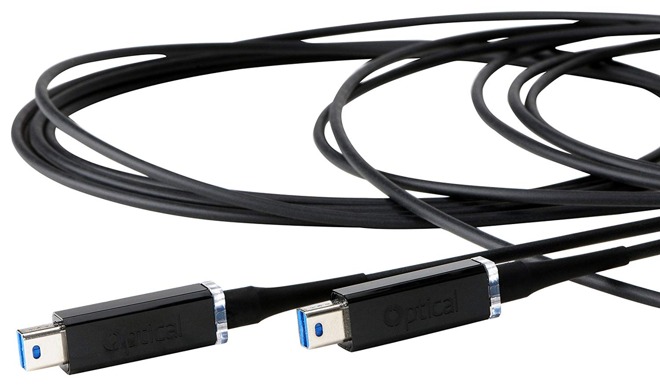Long, optical Thunderbolt 3 cables are coming soon
Sonnet is teaming up with Archiware to demonstrate the first in a line of optical Thunderbolt 3 cables, allowing for high-speed data transfers across the protocol at long range.

Optical Thunderbolt 2 cable, presently available
Sonnet will be demonstrating the new cable connected to a Mac mini with Archiware software running in Sonnet's stand. The Mac mini will be controlled from Archiware's stand over 50 meters of as-yet unreleased Corning optical Thunderbolt 3 cable.
The computer will be running Archiware's P5 media asset management software suite, with P5 Backup, and P5 Archive. Archiware staff will control the system, mounted in a xMac mini Server Thunderbolt 3 enclosure from their stand with a keyboard, mouse, and display connected to a Sonnet Echo 11 Thunderbolt 3 dock.
Prior to the release of the Corning cable, Thunderbolt 3 cable lengths have been limited to about two meters. Sonnet says that varying lengths of the Corning cables will be available, with lengths up to that 50 meters that will be demonstrated at the IBC conference.
Pricing on the optical Thunderbolt 3 cables is not yet available. At present, a 18-foot optical Thunderbolt 2 cable retails for $215, and a 200-foot run retails for $999.

Optical Thunderbolt 2 cable, presently available
Sonnet will be demonstrating the new cable connected to a Mac mini with Archiware software running in Sonnet's stand. The Mac mini will be controlled from Archiware's stand over 50 meters of as-yet unreleased Corning optical Thunderbolt 3 cable.
The computer will be running Archiware's P5 media asset management software suite, with P5 Backup, and P5 Archive. Archiware staff will control the system, mounted in a xMac mini Server Thunderbolt 3 enclosure from their stand with a keyboard, mouse, and display connected to a Sonnet Echo 11 Thunderbolt 3 dock.
Prior to the release of the Corning cable, Thunderbolt 3 cable lengths have been limited to about two meters. Sonnet says that varying lengths of the Corning cables will be available, with lengths up to that 50 meters that will be demonstrated at the IBC conference.
Pricing on the optical Thunderbolt 3 cables is not yet available. At present, a 18-foot optical Thunderbolt 2 cable retails for $215, and a 200-foot run retails for $999.

Comments
Shame Light Peak didn't really get any traction on its own - Thunderbolt was supposed to just be a placeholder while they got the cost of the hardware down. Then again, I was always a bit hazy about how power transmission was supposed to work without the copper. (I mean, it's possible, but it would make the hardware even more expensive and complicated.)
Come to think of it, do the Corning cables support Power Delivery? Or is that specifically a part of the USB spec they don't support?
1. You can run power extension cables to virtually anywhere, making the need to have the optical data cable offer power as well, largely pointless.
2. Adding copper to a cable’s optical data core makes it thick/heavy. Current TB1/2 optical cables only have a ~2mm gauge, v.light, & can bend around obstacles easily.
3. It’s possible that the copper interferes with the optical signal unless shielding is between them both; all making the cable's gauge super-thick thus less manoeuvrable.
4. Adding copper to cables (especially 10/60/100m very long ones) is likely to add cost, and pricing is key to decent enough sales even in pro markets.
5. Power over copper is also likely not enough for many applications. Current Power Delivery is max 100W; many pro things need much more wattage.
6. AFAIUI, power over copper using long distance non-dedicated power cables may deteriorate, meaning power is inconsistent at long distance (not sure?).
If they’re like the TB1/2 optical cables I have, then I highly doubt copper is going to be on these. I really hope they’re not priced as high as the previous TB1/2 ones are, as a shed load of users would and could make great use of these, especially the perennial problem in current users; simply wanting to run loud storage boxes away from ones' desk.
So did this event actually happen? This was a press release saying it will be happening, but I’ve seen no photos, videos, or text saying it actually did happen?
(also, where are the release dates / pricing...? )
See here for Linus...just 2 weeks ago (14.Oct.2019), time: from 16:17: